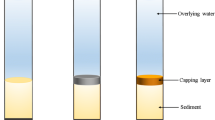Abstract
To treat sulphate pollution resulting from freshwater sediments,an experimental study was done. This experimental study was carried out to determine the effects of pH values and calcium supplements (as CaCl2) on the formation of gypsum in a representative wetland sediment that was aerated. It was foundthat the differences between dissolved sulphate in untreatedcontrol and the other treatments with CaCl2 amendments canbe attributed to the precipitation of gypsum. At the same time, the system was highly affected by Ca adsorption/desorption thatwas controlled by pH values. ECOSAT equilibrium simulations showed that CaCl2 additions (0.2–0.3 mol L-1) to aerated freshwater sediment resulted in removal of 78–98% ofsulphate (from its total content) from the solution. It wascaused by favourable conditions for gypsum formation i.e. acidicpH values were not increased due to the neutral character of CaCl2. On the contrary to CaCl2 amendments, CaCO3supplements (in the same Ca doses as applied in CaCl2) caused the removal of only 5–25% of sulphate. The significantincrease of pH values after the application of CaCO3 limitedgypsum formation due to high saturation of the system with CO3 -2 and HCO3 -. It resulted in the prevalence of CaCO3 formation in this system. However, theaddition of Cl- can facilitate the mobilisation of cationicmetals like Cd and Pb in the form of Cl--complexes. Therefore, CaCl2 treatment should be used in the sites thatdo not contain elevated amounts of these metals.
Similar content being viewed by others
References
Banks, D.: 1996, ‘The Hydrochemistry of Selected Coal Mine Drainage and Spoil-Tip Run-Off Waters’, Longyearbyen, Svalbard. Norges Geologiske Undersokelse Report 96.141, NGU, Trondheim, Norway, 55 pp.
Bell, A. V., Riley, M. D. and Yanful, E. K.: 1995, ‘Evaluation of a Composite Soil Cover to Control Acid Waste Rock Pile Drainage’, CIM BULLETIN 88(995), 41–46.
Bond A. M.: 1980, Modern Polarographic Methods in Analytical Chemistry, Marcel Dekkker Inc., U.S.A., 350 pp.
Greenway, M. and Simpson, J. S.: 1996, ‘Artificial Wetlands for Waste-Water Treatment, Water Reuse and Wildlife in Queensland, Australia’, Water Science and Technology 33(10–11), 221–229.
Henneke, E., Luther III, G. W. and de Lange G. J.: 1991, ‘Determination of Inorganic Sulphur Speciation with Polarographic Techniques: Some Preliminary Results for Recent Hepersaline Anoxic Sediments’, Marine Geology 100, 115–123.
Houba, V. J. G, van der Lee, J. J., Novozamsky, I. and Walinga, I.: 1989, ‘Soil and Plant Analysis, Series of Syllabi, Part 5 Soil Analysis Procedures’, Wageningen Agricultural University, The Netherlands, 100 pp.
Huang, H. H. and Liu, Q.: 1995, ‘Bench-Scale Chemical Treatability Study Bench-Scale of the Berkeley Pit Water’, ACS SYMPOSIUM SERIES, 350 pp.
Karathanasis, A. D. and Thompson, Y. L.: 1995, ‘Mineralogy of Iron Precipitates in a Constructed Acid-Mine Drainage Wetland’, Soil Science Society of America Journal 59(6), 1773–1781.
Karavaiko, G. I.: 1985, ‘Microbiological Processes for the Leaching of Metals from Ores’, Centre of International Projects, GKNT Moscow, 69, 25–30.
Keizer, M. G. and Riemsdijk, W. H.: 1994, ‘Solving Chemical Equilibrium Problems by Means of Computer-Aided Instruction’, Department of Soil Science and Plant Nutrition, Wageningen Agricultural University, 43 pp.
Langer, P.: 1983, ‘FIAstar bibliography No. 458’, Diplomarbeit, Inst. F. Anorg. U. Analyt., Chemie, Technical University of Berlin, W. Germany, 34 pp. (in German).
Lindsay, W. L.: 1979, Two Methods of Handling Chemical Equilibria. Chemical Equilibria in Soils, A Wiley-Interscience Publication, 99 pp.
Maass, B. and Miehlich, G.: 1988, ‘Die Wirrkung des Redoxpotentials auf die Zusammensetzung der Porenlösung in Hafenschlickfeldern’, Mitt. Dtsch.Bodenkunde Ges. 56, 289–294 (in German).
Madsen, B. C. and Murphy, R. J.: 1981, ‘Analytical Chemistry’, FIAstar Bibliography, No. 186, 1926 pp.
Mackintosh, G. and Toerien, D.: 1999, ‘Limestone Mediated Stabilisation of Soft, Acidic Waters’, Water 21, IWA Publishing, 24–26.
Moore, W. S.: 1979, ‘Physical Chemistry’, SNTL Nakl. Tech. Lit. Praha, 450 pp. (in Czech).
Ondrushka, J. and Glombitza, F.: 1993, ‘Inhibition of Natural Microbial Leaching Processes’, in F. Arendt, G. J. Annokée, R. Bosman and W. J. van der Brink (eds), Proceedings of the International Conference Contaminated Soils' 93, Berlin, Kluwer Academic Publishers, Dordrecht, May 1993, pp. 1195–1196.
Rojas-Chapana, J. A., Bartels, C. C., Pohlmann, L. and Tributsch, H.: 1998, ‘Cooperative Leaching and Chemotaxis of Thiobacilli Studied with Spherical Sulphur/Sulphide Substrates’, Process Biochemistry 33, 239–248.
Roos, J. T. H. and Price, W. J.: 1979, ‘Spectrochimia Acta’, in Flame Atomic Absorption Spectrometry, ANALYTICAL METHODS, Manual for Varian, Publication No. 85-100009-00, 446 pp.
Rulkens, W. H., Grothenhuis, J. T. C. and Tichý, R.: 1992, ‘Methods for Cleaning Contaminated Soils and Sediments’, in W. H. Salomons, U. Förstner and P. Madder, (eds), Heavy Metals, Problems and Solutions. Proceedings of the International SETAC Conference, Liblice, Czechoslovakia, October 1992, pp. 81–87.
Stumm, W. and Morgan, J. J.: 1996, Aquatic Chemistry. Chemical Equilibria and Rates in Natural Waters, John Wiley & Sons Inc., New York, 1022 pp.
Van der Heijdt, L. M., Kerkdijk, H. N., Kroot, M. P. J. M., Sonneveldt, H. L. A., Zwolsman, J. J. G., de Rooij, N. M. and Smits, J. G. C.: 1996, ‘Immobilisation of Pollutants in Dredging Sludge and Solid Waste Materials, in J. T. C. Grotenhuis, M. J. Lexmond, H. Rogaar, Van der Heuvel and A. H. Pieper, (eds), Remediation and Isolation Techniques for Soils and Sediments, The Netherlands Integrated Soil Research Programme Reports, 5, 1996, pp. 249–259.
Author information
Authors and Affiliations
Corresponding author
Rights and permissions
About this article
Cite this article
Fajtl, J., Tichý, R. & Ledvina, R. Gypsum Precipitation – A Medium to Control Sulphate Pollution of Freshwater Sediment Leachates. Water, Air, & Soil Pollution 135, 141–156 (2002). https://doi.org/10.1023/A:1014728510286
Issue Date:
DOI: https://doi.org/10.1023/A:1014728510286




